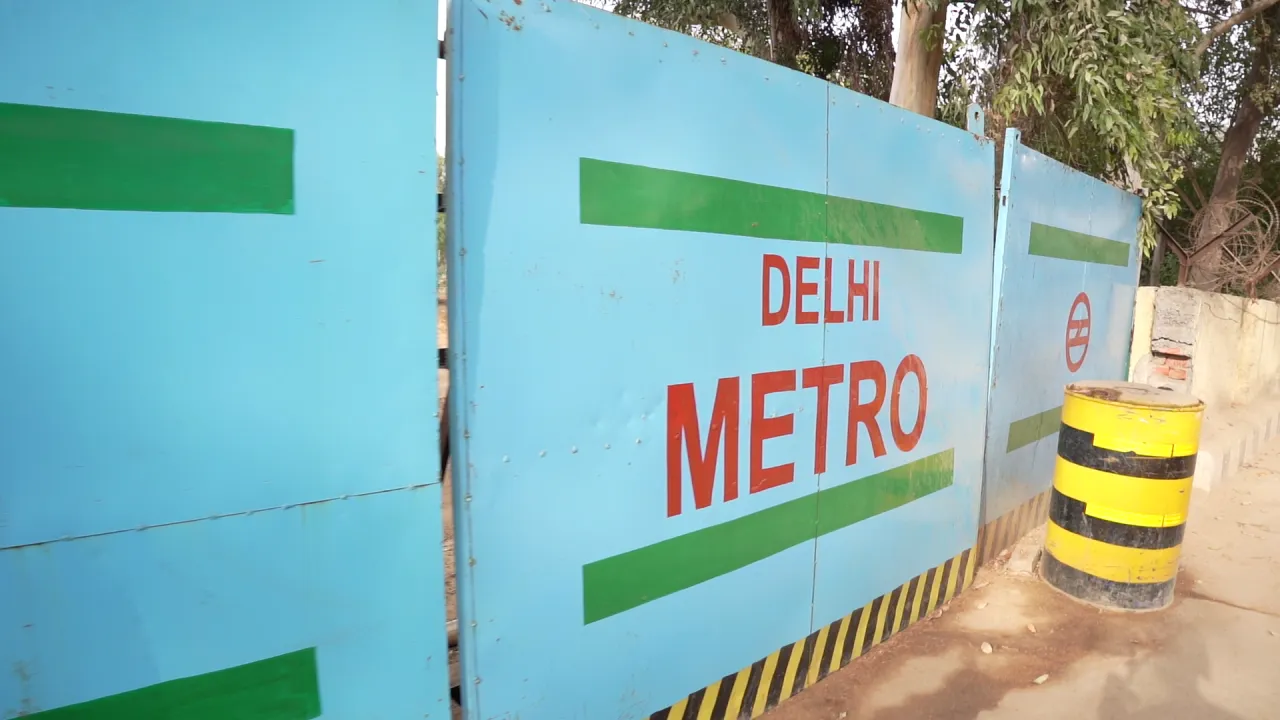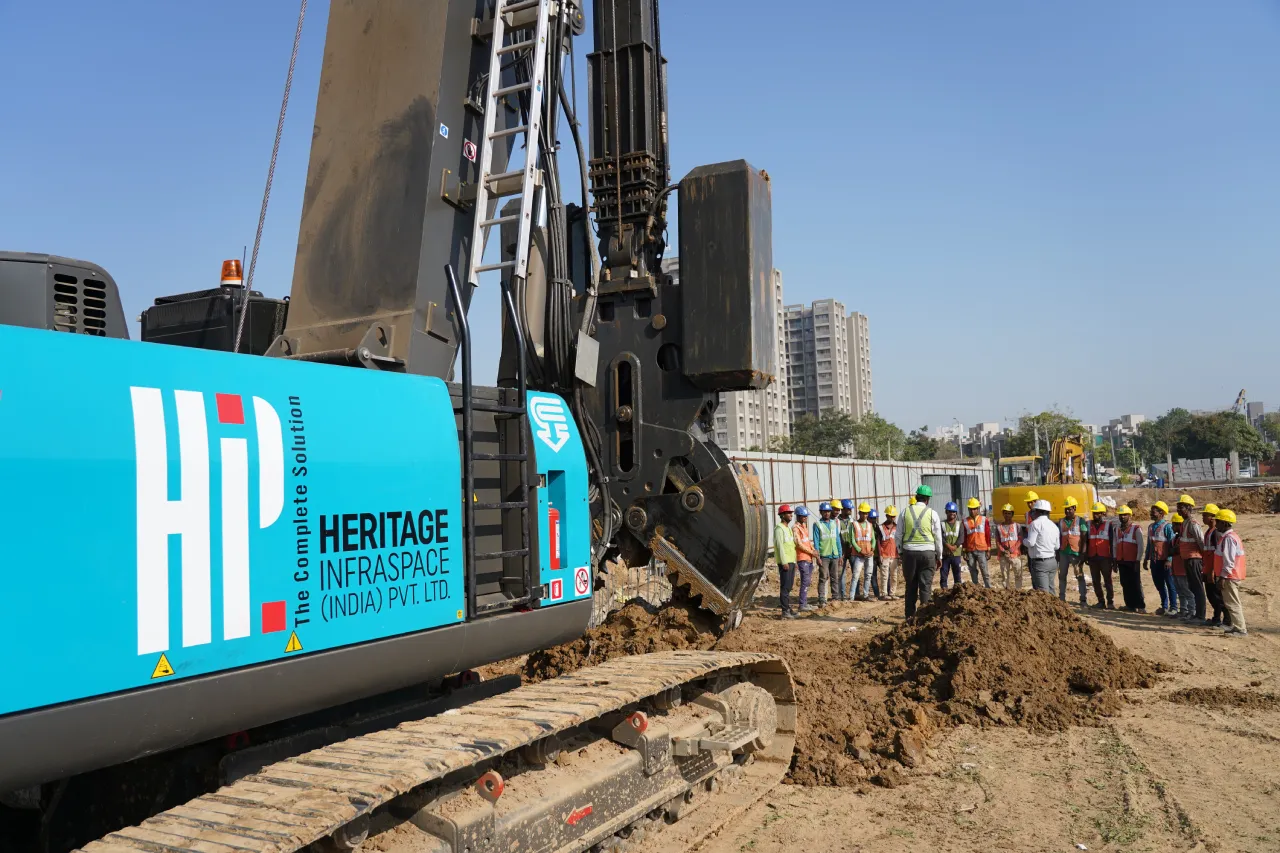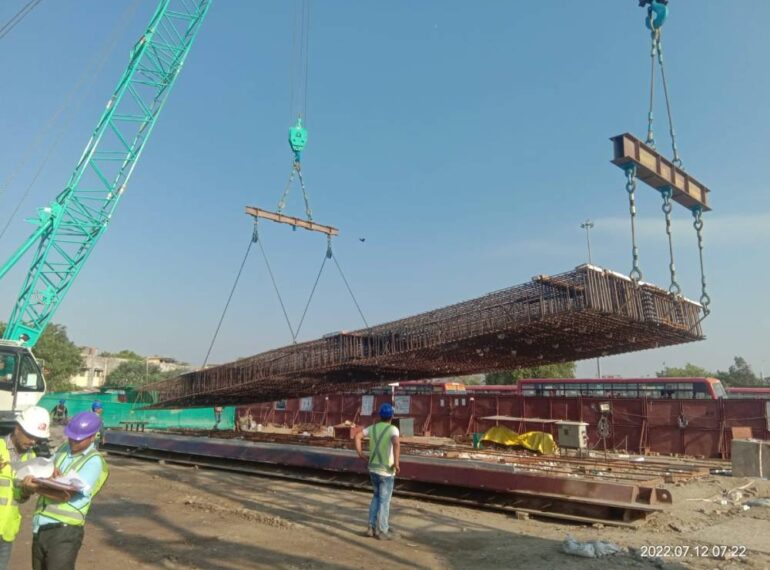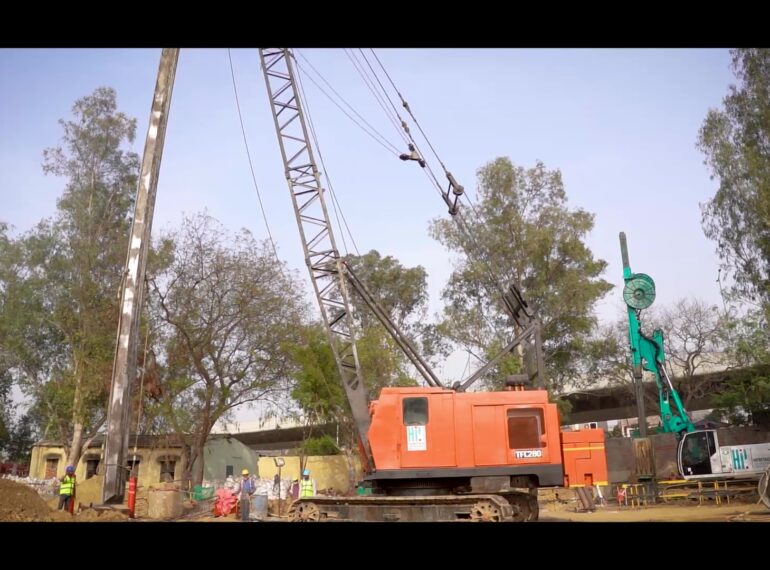Metro Rail has changed the way people commute within cities in India. Constructing such a complex transit system in a populated country like India is a herculean task. We at Heritage Infraspace India Ltd, as a leading D-wall construction company in India, take great pride in the fact that we’ve contributed towards the metro construction in India with our diaphragm wall construction technology, piling and shoring services.
HIPL has provided intelligent ground engineering solutions for various metro construction in India and has executed them with excellence in collaboration with multiple government departments as the top construction company in India. Our diaphragm wall technique or d-wall construction is ideal for basement construction in congested urban areas, as it offers high strength, durability, and stability. We have successfully implemented the construction of a diaphragm wall for metro stations in several cities across India, such as Delhi, Kanpur, Surat, and Agra.
Working with the best diaphragm wall construction company
Heritage Infraspace metro construction includes the thriving Krishna Park station at Delhi Metro, the elevated station stretch of Kalamasherry-Muttam-Pulinchodu-Aluva for the Kochi Metro, the Bada Chauraha and Chunni Ganj stations of Kanpur Metro and the launching shaft for Ahmedabad Metro. All these projects involved the use of diaphragm wall construction technology, which is one of the specialities of HIPL.

HIPL worked with some of the biggest names like Larsen & Toubro on the Kochi and Ahmedabad Metro, Gulermak for the Kanpur Metro and Hindustan Construction Company for the Delhi Metro Project. While construction companies in India were the major project executioners, HIPL was awarded the crucial task of d-wall construction for the deep basement construction of underground metro stations. Our D-wall technique is ideal for congested urban areas, as it offers high strength, durability, and stability.
The Kochi Metro was the first project awarded to HIPL, where we provided our piling services for the elevated stations, constructing 296 piles. HIPL was invited to work on this project when almost every major construction company in India refused to work on the site, majorly because it was close to the dumping yard, which ended up degrading the soil quality and it required some high-level soil management and ground engineering to work on it. We successfully implemented piling construction in Kochi and diaphragm wall for metro stations in other cities across India.
Modern problems require modern solutions
Metros always run amidst the hustle and bustle of modern cities today, hence the construction of underground stations requires innovative engineering solutions with state-of-the-art equipment to execute them perfectly. We use top-of-the-line machinery from our fleet for our diaphragm wall projects, like the Jint SG 35 in Ahmedabad, Casagrande B125 for Delhi Metro and Casagrande B200 in Kanpur.

Another crucial piece of machinery which we use regularly on our sites is the Ultrasonic Drilling Monitor, an intelligent utility device for complex civil engineering and foundation work. We sourced it from Koden in Japan, and use it to maintain the verticality of the construction, where every 10 meters the bore’s verticality is checked with a sensor, and precise measurement, display and recording of perpendicularity of drilled holes and the shapes of cross-sections. The engineers at HIPL also use the top-down construction method for its metro projects, which involves building the underground structure from the top to the bottom, using diaphragm wall construction technology to form the perimeter walls.
Furthermore, we ensure that the soil health is maintained and not damaged post-construction. And for this, we’ve started using polymer solutions in soil maintenance during construction, instead of the traditional Bentonite fluids. This is our way of going green, step by step. We also use vibro stone columns to improve the bearing capacity and reduce the settlement of the soil, by inserting crushed stones into the ground with a vibrating probe. This technique is especially useful for basement construction and d-wall construction in soft or loose soils. We have successfully implemented the construction of a diaphragm wall for metro stations in several cities across India.
HIPL’s Diaphragm Wall Project for Metro Construction (DMRC)
Snippets from HIPL’s project for diaphragm wall construction for metro stations of Delhi’s underground metro rail.
Why choose HIPL for building diaphragm walls in metro stations?
The industry trusts and respects HIPL as one of the top construction company in India, because of the value-added engineering solutions, punctuality in terms of deadlines and maintaining the highest standards of safety for everyone involved in the project and the residents of the adjoining areas of the site.
On every project, a safety manager is appointed to liaison with the clients to fulfil every requirement from the construction safety checklist, and to ensure all the documents and permits to commence work for steel cages, lifts, etc are in place. HIPL takes anywhere close to 4 to 6 months to complete its diaphragm wall construction for metros, despite delays or stoppage in work for any reason.
Further, all the machinery used in the metro construction projects of HIPL are within the standard age of 5 years or less. Plus, every machine is well maintained and ready to hit the ground running from Day 1. As a result of this, HIPL was awarded the Safety Award by the government for maintaining all the crucial safety standards in the Ahmedabad Metro and Kanpur Metro projects.
Want to know more about our process and how we do it email us at info@www.heritageconstruction.in or call 91-9601959595 to start a conversation.
Frequently Asked Questions
A diaphragm wall is a reinforced concrete wall that is constructed in situ using a trench excavated in the ground. The trench is supported by a bentonite slurry to prevent collapse. Reinforcement cages are lowered into the trench and concrete is poured to form the wall segments.
The sequence of construction of a diaphragm wall is as follows:
- Excavate a guide wall along the perimeter of the wall to a depth of about 1m.
- Install stop-end pipes at the ends of each wall panel to form joints.
- Excavate the trench panel by panel using a grab or a cutter, while maintaining the bentonite slurry level.
- Clean the bottom of the trench using a desander or a hydrocyclone.
- Lower the reinforcement cage into the trench and connect it to the stop-end pipes.
- Tremie the concrete from the bottom of the trench to displace the bentonite slurry.
- Remove the stop-end pipes after the concrete has been set.
The machine used for the diaphragm wall depends on the soil conditions and the width of the wall panels. Generally, there are two types of machines: grabs and cutters. Grabs are clamshell buckets that can excavate soil by closing their jaws. They are suitable for soft to medium soils and narrow wall panels. Cutters are rotating wheels with cutting teeth that can excavate soil by spinning. They are suitable for hard or mixed soils and wide wall panels.





